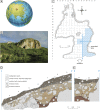Archaeological evidence for two separate dispersals of Neanderthals into southern Siberia
- PMID: 31988114
- PMCID: PMC7022189
- DOI: 10.1073/pnas.1918047117
Archaeological evidence for two separate dispersals of Neanderthals into southern Siberia
Abstract
Neanderthals were once widespread across Europe and western Asia. They also penetrated into the Altai Mountains of southern Siberia, but the geographical origin of these populations and the timing of their dispersal have remained elusive. Here we describe an archaeological assemblage from Chagyrskaya Cave, situated in the Altai foothills, where around 90,000 Middle Paleolithic artifacts and 74 Neanderthal remains have been recovered from deposits dating to between 59 and 49 thousand years ago (age range at 95.4% probability). Environmental reconstructions suggest that the Chagyrskaya hominins were adapted to the dry steppe and hunted bison. Their distinctive toolkit closely resembles Micoquian assemblages from central and eastern Europe, including the northern Caucasus, more than 3,000 kilometers to the west of Chagyrskaya Cave. At other Altai sites, evidence of earlier Neanderthal populations lacking associated Micoquian-like artifacts implies two or more Neanderthal incursions into this region. We identify eastern Europe as the most probable ancestral source region for the Chagyrskaya toolmakers, supported by DNA results linking the Neanderthal remains with populations in northern Croatia and the northern Caucasus, and providing a rare example of a long-distance, intercontinental population movement associated with a distinctive Paleolithic toolkit.
Keywords: Altai Mountains; Chagyrskaya Cave; Micoquian artifacts; Middle Paleolithic; Siberian Neanderthals.
Copyright © 2020 the Author(s). Published by PNAS.
Conflict of interest statement
The authors declare no competing interest.
Figures



References
-
- Arsuaga J. L., et al. , Neandertal roots: Cranial and chronological evidence from Sima de los Huesos. Science 344, 1358–1363 (2014). - PubMed
-
- Higham T., et al. , The timing and spatiotemporal patterning of Neanderthal disappearance. Nature 512, 306–309 (2014). - PubMed
-
- Turner C. G., II, Chronostratigraphy of the Paleolithic in North, Central, East Asia and America, Derevianko A. P., Ed. (Institute of History, Philology and Philosophy, Siberian Branch of the USSR Academy of Sciences, Novosibirsk, 1990), pp. 239–243.
-
- Krause J., et al. , Neanderthals in central Asia and Siberia. Nature 449, 902–904 (2007). - PubMed
Publication types
MeSH terms
LinkOut - more resources
Full Text Sources

